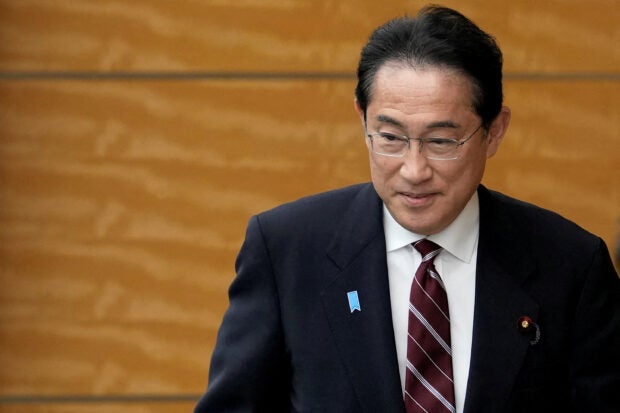Japan keeps growth focus but signals end to crisis-mode fiscal largesse

Japanese Prime Minister Fumio Kishida arrives for a bilateral meeting with Laos’ President Thongloun Sisoulith, at the prime ministers’ office in Tokyo, Japan, Thursday, May 25, 2023. Shuji Kajiyama/Pool via REUTERS/File photo
TOKYO -Japan is committed to putting the economy before fiscal reform, Prime Minister Fumio Kishida’s government said in its draft mid-year policy framework, while signaling an end to crisis-mode stimulus spending to return to one in “peacetime”.
The draft framework, which was presented at Kishida’s top economic advisory panel on Wednesday, underscored the challenge for Kishida, seen as a fiscal hawk, to strike a balance between economic growth and fiscal consolidations.
“As we emerge from the coronavirus crisis and as the economy normalizes, we strive to prevent crisis-time fiscal spending from being prolonged, while bringing spending structure back to peacetime,” it said.
The closely-watched policy framework will be approved by his cabinet this month, along with a separate action plan on his “new capitalism” agenda.
“Japan has been an outlier of the global trend that has moved away from crisis-mode stimulus. Policy normalization is definitely a step in the right direction,” said Takahide Kiuchi, executive economist at Nomura Research Institute.
“It’s easier said than done though, given his big spending plans with doubling defense and child care spending,” while general elections are looming large, Kiuchi said.
The framework dropped a specific timeframe on the budget-balancing target for a second year, reflecting a compromise Kishida may strike with reflationary forces within his own Liberal Democratic Party ₍LDP₎. Analysts see the budget-balancing goal as rather symbolic.
“We will not abandon the flag of fiscal reform,” the framework said. “We will restore the economy and tackle fiscal consolidation. However, we must also closely watch recent price hikes and economic situations in Japan and overseas as always.”
Currently, Japan aims to swing a primary budget surplus, which excludes new bond sales and debt-servicing costs, by the fiscal year ending in March 2026.
The target was originally set for achievement in the early 2010s but has been delayed four times since then.
Several rounds of heavy stimulus spending to cope with COVID-19 pushed up the annual budget from some 100 trillion yen to around 140 trillion yen ($1 trillion) during fiscal 2020 to 2022 years, straining the industrial world’s heaviest public debt that is more than double the size of Japan’s economy, the world’s third largest.
The framework said the government will conduct a review of any progress of its fiscal reform in the fiscal year 2024 so as to create a medium-term economy and fiscal scheme.
Since he took office in October 2021, Kishida has pledged to achieve a virtuous cycle of growth and redistribution under his “new capitalism” while suggesting that previous administrations’ stimulus policies created social division and inequality.
To accelerate the “new capitalism” drive, the draft calls for the expansion of child care measures and households’ assets as well as the overhaul of asset management firms. It encompasses reform to spur labor turnover, respond to artificial intelligence (AI), strengthening of supply chains and promotion of green and digital transformation.
“We will realize sustainable growth by mobilizing budget, taxation and regulatory reforms, aiming to exit deflation and overcome falling childbirth,” it said. “We will conduct flexible policy while working closely with the Bank of Japan” which will aim for the 2 percent inflation target accompanied by wage hikes.
($1 = 139.4600 yen)
IMF urges BOJ to keep ultra-low rates, but be ready to shift course
Subscribe to INQUIRER PLUS to get access to The Philippine Daily Inquirer & other 70+ titles, share up to 5 gadgets, listen to the news, download as early as 4am & share articles on social media. Call 896 6000.






